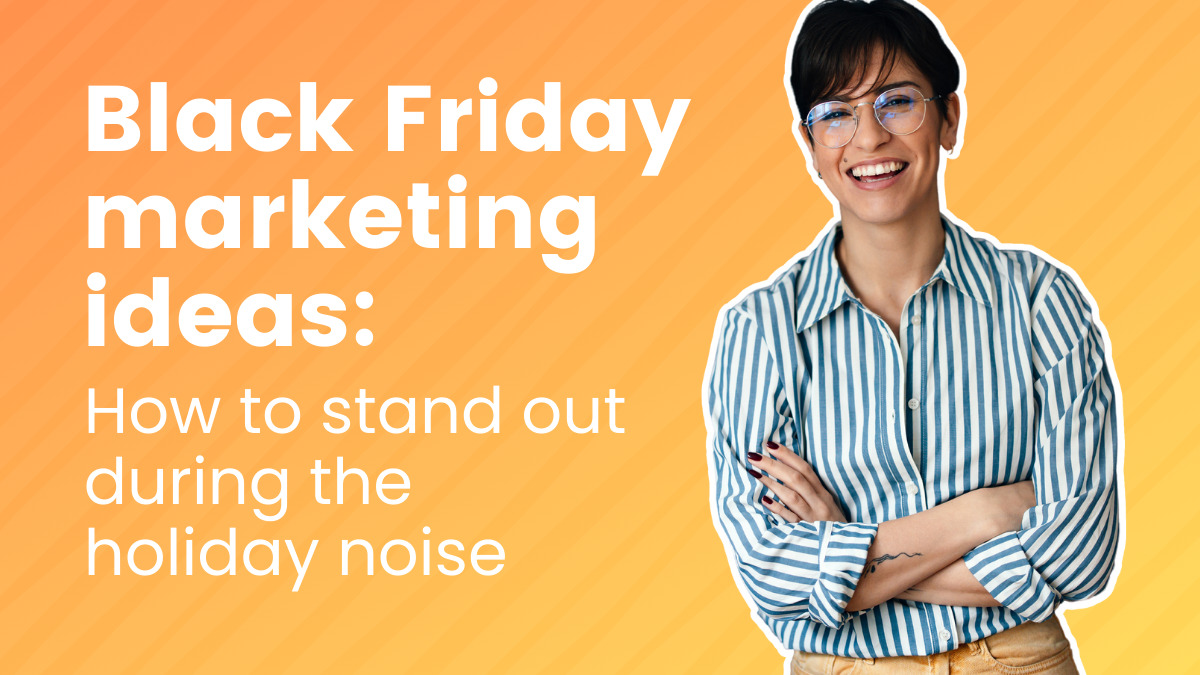By Kaleigh Moore October 17, 2023
Black Friday is the kickoff to the holiday season, the time of year when every customer is rubbing their palms together and ready to shop.
This makes it the perfect time to launch a marketing campaign, right?
Well, kind of.
The thing is, you’re not the only business to have heard of Black Friday.
In 2022, shoppers poured out $9.12 billion on Black Friday alone. That creates an intense level of competition for every customer dollar. What the Superbowl is to advertisers—that’s what Black Friday is to marketers.
If you want to make more sales, you’ll need to stand out.
But there’s no silver bullet here, no single miraculous strategy. You should choose a seasonal, brand-appropriate strategy that fits your customer colchoneta without being too pushy.
Your goal? Learn how to make noise during the holiday shopping season to stand out. But do it without rubbing customers the wrong way.
To accomplish that, you’ll need all sorts of Black Friday marketing ideas. We’ve put together a list of them and organized them by category for easy browsing.
Choose the ones that fit your market, then combine them for an especially effective campaign.
This is a comprehensive list, so to help you sort through them all, we’ve divided them into several categories:
How do they stack up? Let’s look at some effective strategies and examples you can use to stand out when Black Friday competition is in full force.
Capitalize on holiday gift-giving
Yes, the holidays are the season for giving.
But something else happens when we start shopping with others in mind:
We shop for ourselves, too.
One survey found that almost 7 out of 10 Americans plan to shop for Black Friday and Cyber Monday sales. 50% of those shoppers report spending the most on gifts. But another 30% say they’ll shop for necessities for their home or family.
Given that in 2022, holiday sales grew to $936.3 billion, this becomes the ultimate point-of-purchase marketing opportunity.
And it happens on a national scale.
The holidays are when people scroll their phones for gift ideas, tapping “add to cart” as quickly as sending reply texts or checking the weather.
To make a mark during this season, you should fit your brand neatly into what people already do.
They’re looking for gifts.
Create a gift guide
People don’t just need gifts during the holidays. They need gift ideas.
That may be why emails featuring gift ideas report 48% higher sales than the standard fare.
Yes, the holiday season is when customers are most willing to spend their money. But it doesn’t mean customers put zero thought into their gifts.
If anything, it’s the opposite. Customers want to buy smart, thoughtful gifts—they just don’t know where to find them.
The holiday gift guide is the antidote to holiday shopping procrastination. If your business assembles a list of product recommendations with specific gift recipients in mind, it can convert customers from gift researchers to gift buyers.
There are a few benefits to creating a gift guide:
- Highlighting products that create high promedio order value (AOV). Pumping up your promedio order value during the holidays means you can scale your revenue even if you don’t see total orders go up. With a holiday gift guide, you can “push” those items that tend to require cross-sells, increasing AOV.
- Visibility and brand awareness. Think of gift guides as a form of content marketing. People are looking for gift recommendations all the time—your guide helps solve a highly specific pain point.
- Capitalizing on trends. Highlight the products you offer that meet the latest holiday buying trends. This can swiftly boost your AOV and generate interest in the rest of your inventory.
Don’t just create one gift guide, either. Create them for particular demographics to add to their unique appeal.
For example, “gifts for toddlers” or “gift ideas for grandma” are popular keywords. And people who struggle with shopping ideas will appreciate the specificity.
Finally, group your items with cross-sales in mind. Write a holiday gift guide like “gifts for crafts-lovers.” If you want to encourage upsells, try a “stocking stuffer gift guide.”
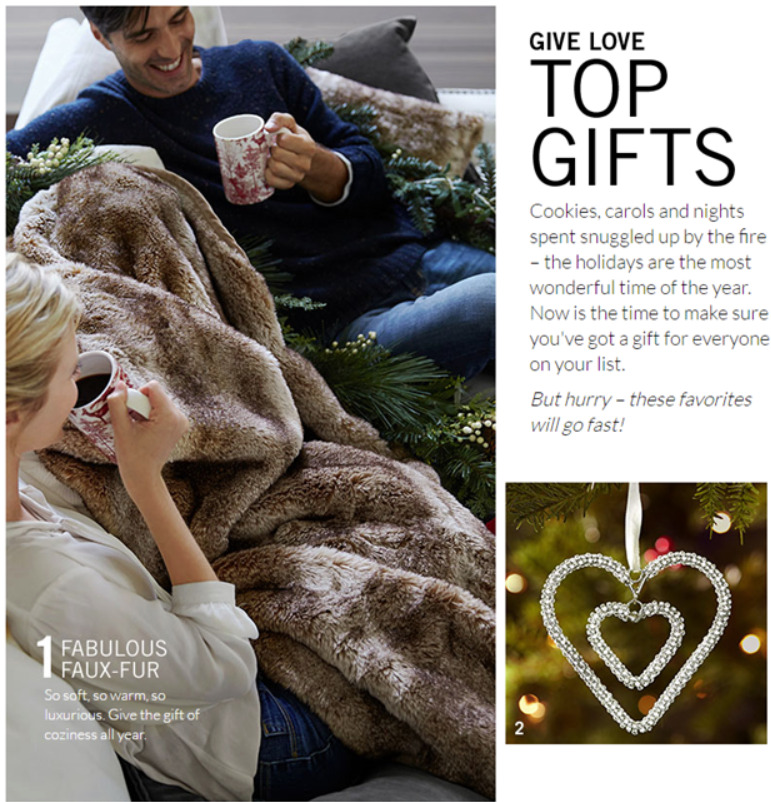
Pottery Barn’s gift guides are an annual favorite for good reason: they put in the work.
At their guide, you’ll find what’s in-stock, gifts sorted by price, gifts for him, gifts for her—even a “plaid” shop if that’s your aesthetic.
Sure, maybe your shop isn’t quiebro Pottery Barn-ready. But you’ll be amazed at how much you can inspire holiday purchases by giving customers the blueprint for their shopping spree.
Incentivize purchases with gifts
Minimalist Baker was looking for a way to encourage email signups. The best strategy was simple: enticing customers with a gift.
With a free 49-page eBook full of recipes, Minimalist Baker encouraged new readers to become new subscribers.

You can use the same principle.
But you don’t have to limit yourself to email campaigns. You can incentivize a flurry of activity simply by offering holiday-appropriate gifts, like:
- Free shipping that kicks in when a customer goes above a certain order value (i.e., free shipping with $100 orders)
- Two-for-one deals that encourage customers to add more items to their cart
- Free discount codes when customers download your holiday gift guide
- Free giveaways for your lead magnets
- Discounts for random customers who shared a social media hashtag of yours
- Random offers for people in your email marketing segment/customer VIP list
Why gifts? The fact that it’s the holidays is convenient, sure. But it’s not the whole story.
Giving out freebies plays on the principle of reciprocity. When customers receive an unexpected gift, they sometimes need to return the amparo. They can do that by shopping from your store during the holidays.
Ever wonder why grocery stores give out free samples?
It’s not because they’re feeling charitable. It’s because it’s hard to say no to a gift. And merienda you’ve tasted the sample, you’re stuck with the seed of an idea:
Hmmm. Maybe I should check out that store again.
Create value by offering donations
Let’s be clear: not everyone loves Black Friday.
Shopping sprees around the holidays strike some as too commercial. Maybe Charlie Brown had a point: the true meaning of these holidays often gets lost in the weeds.
This has a verdadero effect on how people shop. About 20% of people say they’ll shop on Black Friday, but nearly just as many—about 17%—say they plan on doing their shopping afterward.
44% of adults hate or dislike the big shopping frenzy around the holidays.
So what do you do? Get back to basics.
People are still going to shop on Black Friday because they want to buy gifts. If you want to avoid the “ick” of commercialism, remind people that it’s not all about the money.
Take Sakara as an example. The company created a holiday campaign where every $75 purchase triggered a donation to Feeding America.
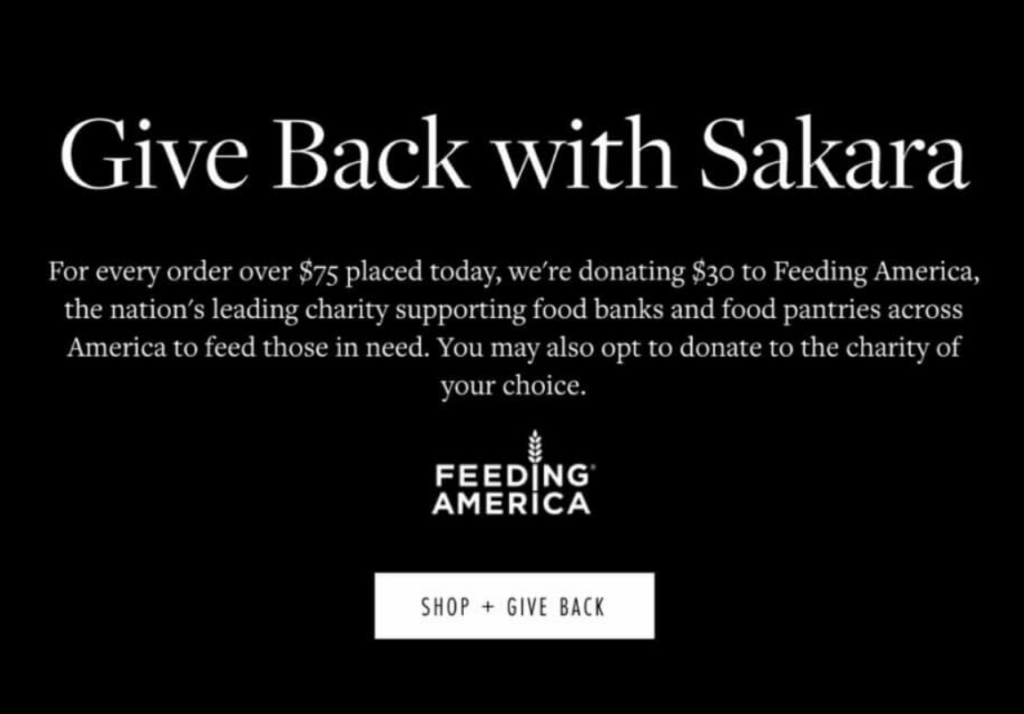
That’s perfectly in line with all sorts of great values. It’s on-point with the branding. It highlights what creates Black Friday in the first place: the day after Thanksgiving, when many of us are feeling well-fed.
So if you want to spur the Black Friday doubters to action, remember to give back.
Offer discounts on gift cards
It’s not just over-commercialism that makes some people hesitant around the holidays.
It also comes down to economics.
You might have noticed inflation’s been rampant lately. It has a verdadero impact on Black Friday. Over two-thirds of U.S. consumers say they’ll spend less on holiday gifts due to inflation concerns.
Don’t ignore these concerns. If anything, your marketing should lean into them.
One solution is to offer gift cards. People who want to shop but have been waiting for the “deals” can jump on these offers. Rather than paying full price, they feel they’re getting a special discount.
If people are coupon-clipping this holiday season, offering discounted gift cards is a great way to give customers what they want.
Sephora’s famous VIP list is a prime example here. They’ll incentivize customers to higher order sizes by offering gift cards, essentially creating discounts on new purchases.
To the new customer, it feels like a holiday gift. From Sephora’s point of view, it’s an incentive to join the program.

Additionally, spending gift cards doesn’t feel like spending money, even if your business’s bottom line is the same.
Even if they’re worried about inflation, customers will still shop on Black Friday. If you can incentivize people to buy and share gift cards for your products, you’re well on your way to a successful Black Friday marketing campaign.
Offer seasonal incentives
You know the phrase: ‘Tis the season.
Nearly 13% of annual retail sales happen between Black Friday and Christmas.
This is crunch time for marketers. The ultimate buying season. The fourth quarter—with only a few seconds left on the play clock.
And that’s why the seasonal approach works. All sorts of unique discounts and gift bundles make sense on Black Friday when they wouldn’t make sense at any other point in the calendar.
Here’s how to use that fact to your advantage.
Conditional free shipping to increase AOV
Nothing inspires customers to shop quiebro like free shipping.
Every time a customer pulls up an order, free shipping adds a little bit of an incentive. It’s almost like they’re using some sort of cheat code.
In one survey, most online shoppers said they look for free shipping—at a rate of 76%.
How important is free shipping? Consider this: price only scored 73%.
Two-thirds of customers won’t even consider purchasing if you don’t offer it. Shops like Amazon and its two-day free shipping with Prime have raised the bar for everyone. Now, when people shop online, shipping fees feel like paying “extra.”
But you can inspire sales with some creative free shipping offers.
Take Portrait Coffee. They pitched their free shipping as a seasonal incentive.
The idea was simple: “Order now, because this free shipping is going away soon.”

The result? Combining two marketing ideas—free shipping and seasonality—builds urgency.
Customers want that free shipping, and they’ll be willing to order sooner to beat the clock.
Create category discounts
Do you have specific product categories that tend to perform well? Especially during the holidays?
Then there’s no better time for a category-based discount.
Category-based discounts are simple enough. They say: “save 10% off all of our XYZ products if you buy between now and Christmas.”
Yes, it’s a simple discount strategy. But if you can find a good match between the holiday season and one of your product categories, you’ll also have urgency built right into the category discount.
And what if you don’t have a holiday-ready category like “Christmas trees” ready to sell?
Get inventive. That’s why tools like WooCommerce will let you set product tags. You can use these to create categories that are specific to the holidays.
This is an effective strategy for shops that don’t have especially seasonal offerings. But maybe you do have many products that fit in the palm of your hand and cost less than $20.
Bingo: you’ve got a new “stocking stuffer” category.
It works so well, some companies like LL Bean even throw in the stockings as a custom order.

You may have to get creative with your categories and product tags to build a discount that makes sense for the holidays. But when you do, you’ll have a recipe for automatic seasonal urgency.
Customers will have to either pony up or wait until next year.
Bundle gift-ready products into promotions
Product bundling is when you pair two or more products together and sell them as a single unit.
Let’s distinguish this from cross-selling. Cross-selling refers to sales recommendations based on an existing order. It asks customers to add another order to their cart.
But with a bundle, you create what’s essentially a unique product. Customers can take it or leave it.
Why is it so appropriate for the holiday season?
In a word: themes.
Even if you don’t have a full category of products to discount, you can build product bundles for holiday purchases.
The great thing about product bundles: they play into holiday shoppers’ sense of frugality. They’re not adding items to their cart, they figure. They’re buying in bulk.
Offer a discount on a few select holiday-themed bundles, and you don’t have to offer new holiday products.
Think of product bundles as creating new products out of existing offerings. From your end, there’s barely any extra logistical work.
From the customer’s end, bundles feel like entirely new products.
Do it right, and you can increase the AOV (promedio order value) even when you offer discounts. It’s a great way to do a subtle “cross-sell” that isn’t a cross-sell, taking advantage of the influx of holiday traffic.

For NatureBox, assembling gift ideas like the “Less Stress Box” or “Everyone’s Favorites Box” doesn’t require manufacturing new snacks.
They’re simply the same products in different bundles.
Build urgency during the holidays
There’s a reason seasonal incentives work during Black Friday marketing campaigns: time is short.
Everyone knows the holiday season doesn’t last forever. Even if you offer sales all year long, there’s something inherently urgent about a “Black Friday” or “Holiday Sale” that rings with extra resonance.
The holidays only come merienda a year, after all.
But how do you top the previous section and build more urgency into the holiday season? Here are a couple of ideas.
For yearly subscriptions, launch rare time-sensitive deals
If you sell yearly subscriptions, there’s no day like Black Friday.
Internet traffic is up. People are ready to pay more money. Everyone’s ready to shop.
The added advantage of selling yearly subscriptions is the increase of the lifetime value of each customer.
Holidays are especially great for these, as are any yearly anniversaries.
Look at Peak Freelance, for example. They used a “business birthday” to offer a discount on their subscription.
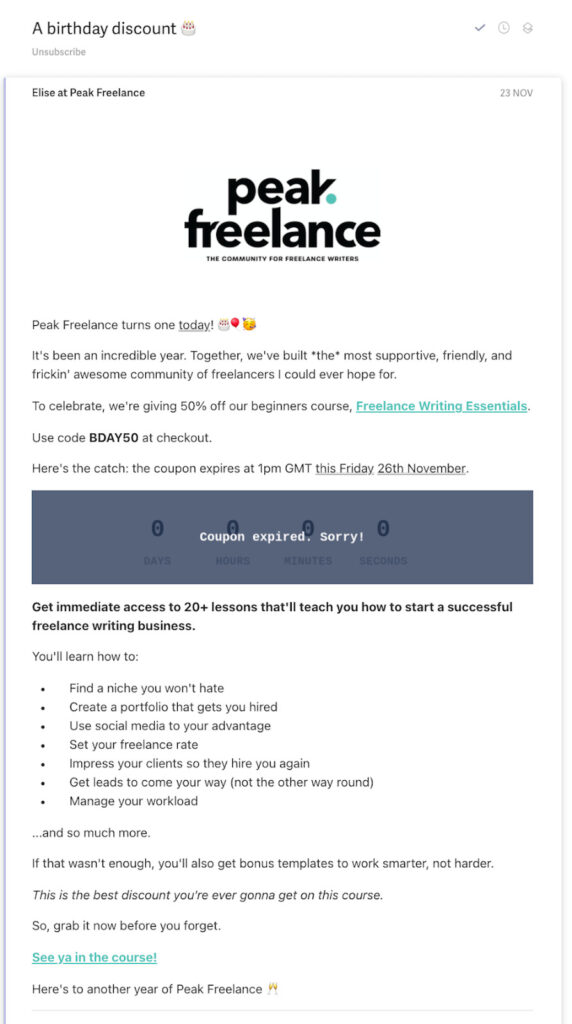
They didn’t have to work hard to build in urgency here. And they didn’t say, “It only comes merienda a year!” The urgency is already implied.
Any time you can imply urgency without spelling it out, you can avoid marketing that sounds too pushy.
That’s especially important during Black Friday, when your goal is to get noticed without writing emails or ad copy that sound like you’re using a bullhorn.
Put a timer on your marketing campaign
Another way to avoid pushy messaging?
Let the clock do your talking.
One common tactic is to attach a specific timer—down to the minute—with a discount code. Add it to your landing page with a timer that says “time left to redeem,” then attach a countdown.
You don’t have to do a lot of sales with this one. You simply need two elements:
- A marketing campaign with a built-in countdown. One example of this is a Valentine’s Day sale. Everyone knows it’s a holiday without a season—it’s just twenty-four hours left to redeem. Black Friday follows the same rules.
- Build the timer into your CTA. Just beneath your call-to-action, put the timer in and let the clock wind down. Seeing each second tick by will build in automatic urgency. This lets customers watch as the sand slips from the hourglass.
It helps if you make it clear what the timer’s for. “Two hours left to redeem your offer” is far more compelling than “Click here to buy!”
Take Kate Spade’s Valentine’s Day offer. Even though we all know how long Valentine’s Day lasts, that “countdown” builds in a gut-level urgency that makes clicking “Shop Now” feel like an imperative.

Black Friday shopping should never be a slog.
It should feel communal, exciting, energizing. Marketing campaigns should unravel more like stories than hard sales pushes.
The question is: how do you make shopping more fun when you’ve only got a limited season to work with? Here are a few ideas.
Promote UGC (user-generated content)
User-generated content (UGC) are online posts where your customers do the heavy lifting.
For example, let’s say you launch a branded hashtag to coincide with your marketing campaign. Let’s say you sell a line of handcrafted jewelry.
You go to your social media platforms like X and Instagram and tell your customers to post photos of themselves with your jewelry, using #BlackFridayBling.
To sweeten the pot, you announce one lucky winner will get a 90% discount for any Black Friday purchase up to $500.
Suddenly, you’ve got an influx of people posting #BlackFridayBling.
Photos storm social media. One influencer with 10,000 followers posts themselves wearing your jewelry. Your site gets overwhelmed with traffic.
That’s the power of UGC. It turns your Black Friday marketing campaigns into potential virulento hits.
Another advantage to UGC is that it’s low-budget. All you did in this example was leverage an existing social media platform and offer a one-time discount for one winner.
Sometimes, you simply need a hashtag that resonates with your particular audience.
Take REI’s “#OptOutside” campaign. This campaign went against the usual Black Friday grain and asked people to simply post pictures of them heading outdoors during the shopping spree.
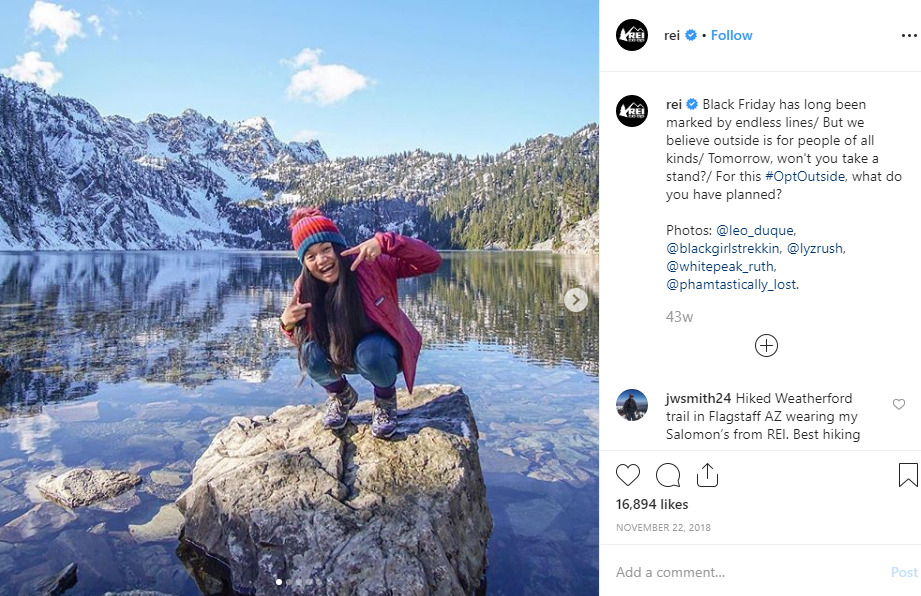
If you need help getting your UGC campaign off the ground, apps like Heyo can offer a platform for systemizing your UGC efforts. Plan this far in advance, because just another “#BlackFriday” contest won’t be enough to break free of the noise.
Look for your version of “#OptOutside.” If you can inspire people to participate in your campaign, it’s well worth the time it took to brainstorm the right hashtag.
Unpeel the marketing onion
Sometimes, the best way to have fun with shopping is to tell an engaging story.
Let’s call this particular Black Friday marketing strategy “unpeeling the onion.”
Like a good mystery novel, unpeeling the onion means you only reveal one clue at a time—before unveiling the big picture.
IHOP famously did this when it became IHOB for a brief time. What was IHOB? People had to guess.
It opened a fun mystery, getting people talking about why a famous brand would undergo such a drastic change.
Ultimately, the campaign was about letting people know they sold burgers at IHOP—hence the “B.”
Eventually, it got so much attention, even other brands started weighing in:
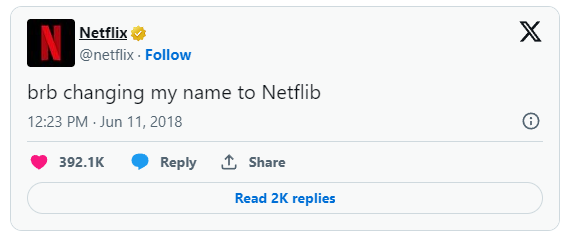
If they hadn’t taken the time to unpeel the onion with one layer of mystery at a time, they wouldn’t have generated so much buzz for their new afternoon offerings.
Stir a sense of exclusivity and excitement
When Black Friday rolls around, everyone can see the calendar year dwindling. The year’s about to end. The holidays are here, and it’s time to turn over a new leaf.
This means customer emotions are ripe for stirring. Whip up a sense of exclusivity or excitement in your Black Friday marketing campaigns, and your customers will reward you.
Here are a couple of ideas:
Host flash sales
A “flash sale” has time-sensitive urgency built right in.
The challenge? Flash sales are short. It can be tough to get enough customers to pay attention by the time the flash sale is over.
That’s why the key to making it work is to let people know in advance that a flash sale is about to happen.
Build your campaign around this messaging. In Blue Apron’s case, they used “beat the clock” messaging that made shopping at Blue Apron sound like a game.
(Along with a healthy dash of FOMO: fear of missing out).
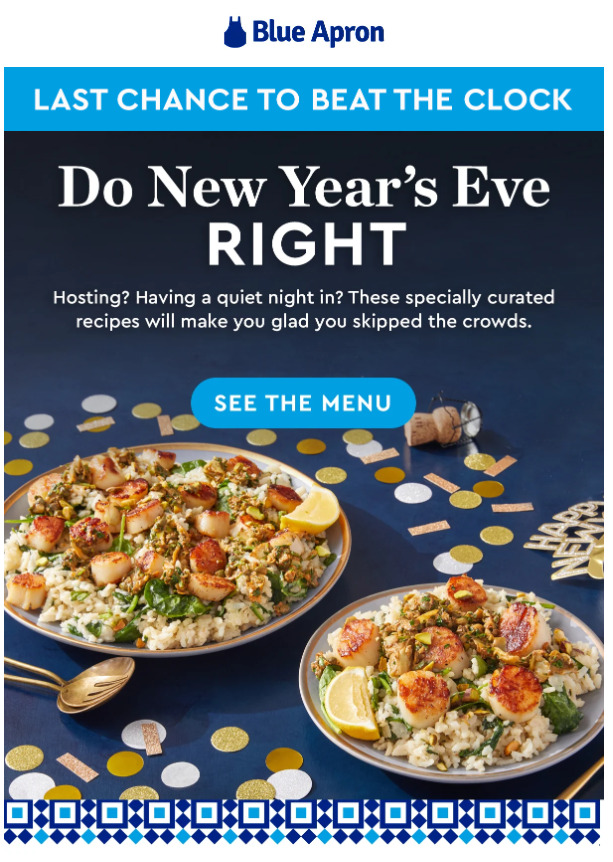
You can use other gamification strategies for shopping, too, like adding up VIP points with each purchase, or encouraging people to spend a minimum amount to earn certain rewards.
The more fun you make buying, the more customers will keep coming back—and tossing a few extra products in their cart.
Create deals for VIPs/previous customer email segments
Segmenting your emails is a great way to personalize your Black Friday marketing strategy, which makes every campaign that much more effective.
When writing emails to one specific segment of people, the sense of “exclusivity” will bake right in.
Your results will depend on how specific you get with your segmentation. You can try to create a few customer segments that identify specific pain points according to behavior:
- Purchase history: Divide people based on their purchase history—and try targeting people who have purchased before but haven’t visited in a while
- Purchase amounts: Is there a specific segment of customers just under the minimum to unlock new discount codes?
- Purchase frequency: Treat high-frequency customers to a unique discount code to encourage them to come back; or have them refer a friend
- Website behavior: When you know who’s visited a specific landing page without converting into a customer, you can craft highly targeted messaging designed to win them back
For the Chipotle Rewards program, they reward frequent purchases by unlocking the kinds of rewards frequent customers would like: 2x reward points, first access to “insider” product releases, even free guacamole for signing up.

The more personal your marketing gets, the more likely it is to resonate. Don’t create Black Friday marketing campaigns that apply to everyone. Get specific.
Stand out with the right mix of Black Friday marketing ideas
You don’t have to try out every idea on this list. But if you find the right mix to capitalize on the gift-giving spirit or stir up a sense of exclusivity in your customer colchoneta, there’s probably a campaign or two that will help you stand out from the crowd this Black Friday.
Try out a few of these marketing ideas and watch your revenue. If you notice any that increase your sales, you’ve got a recipe for a future Black Friday marketing strategy to move the needle.


